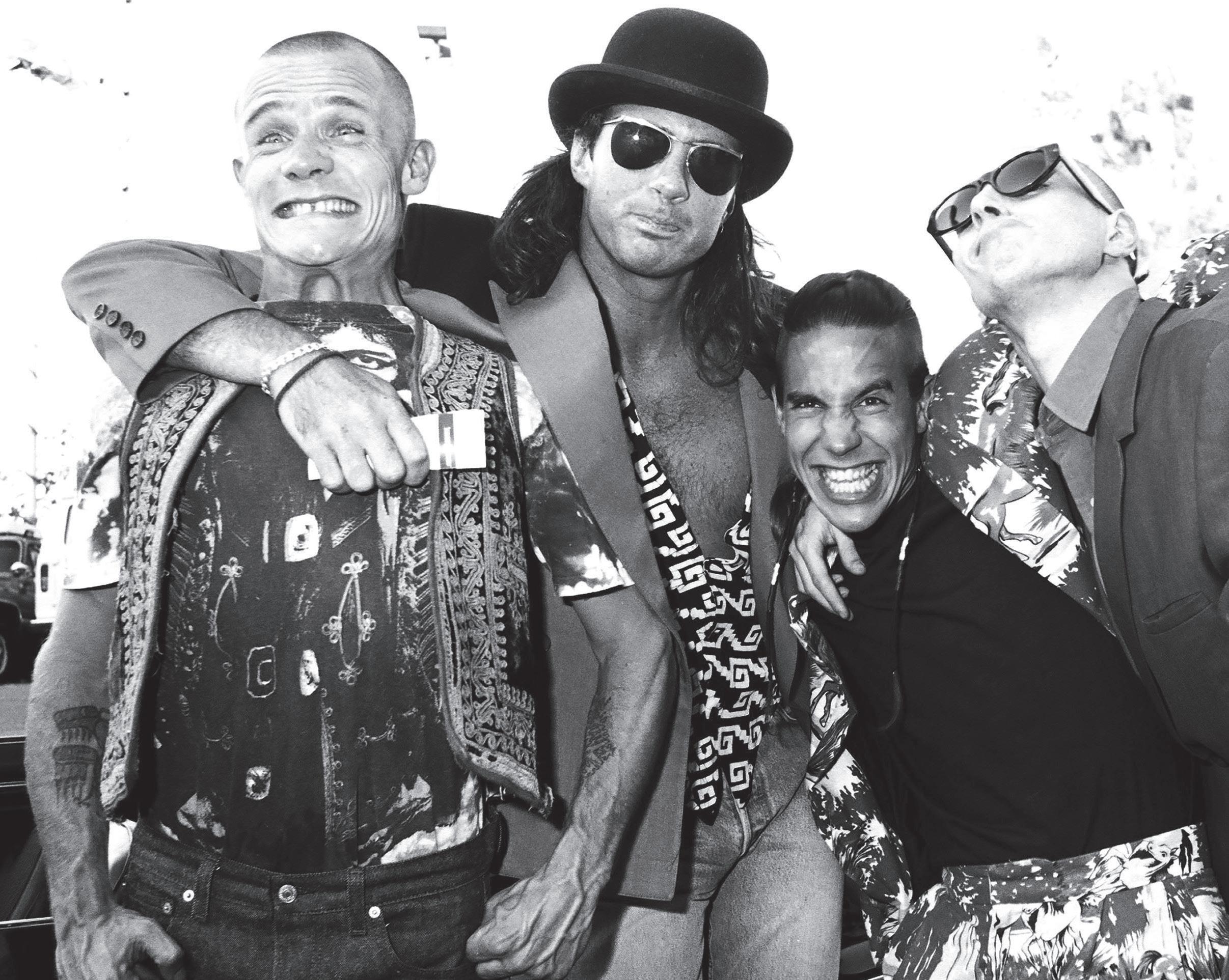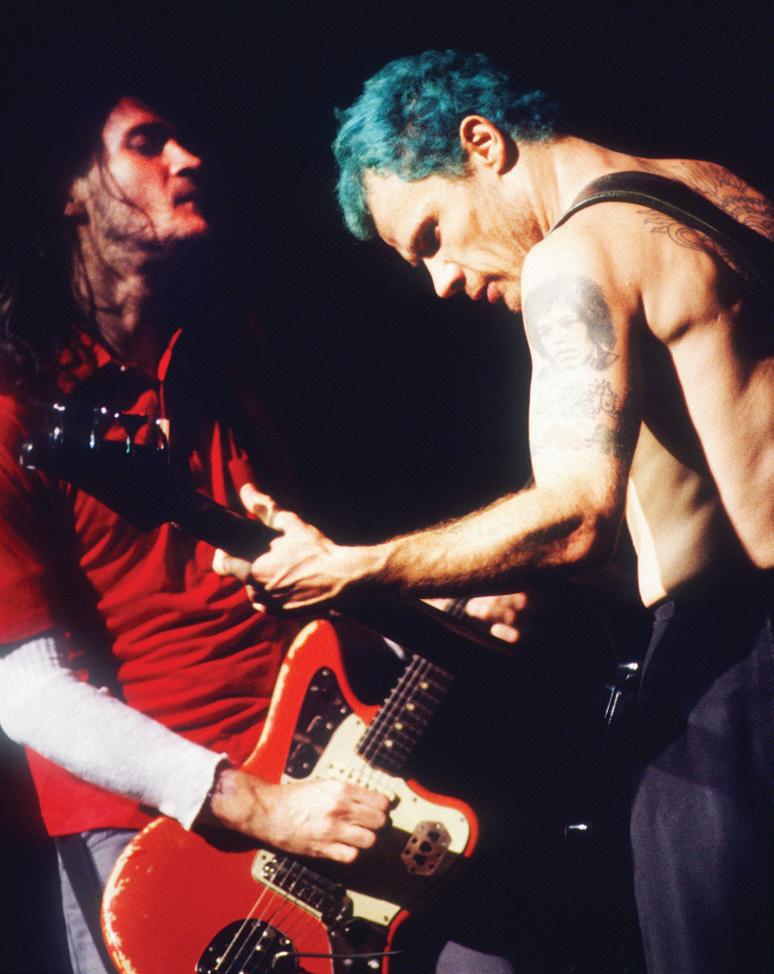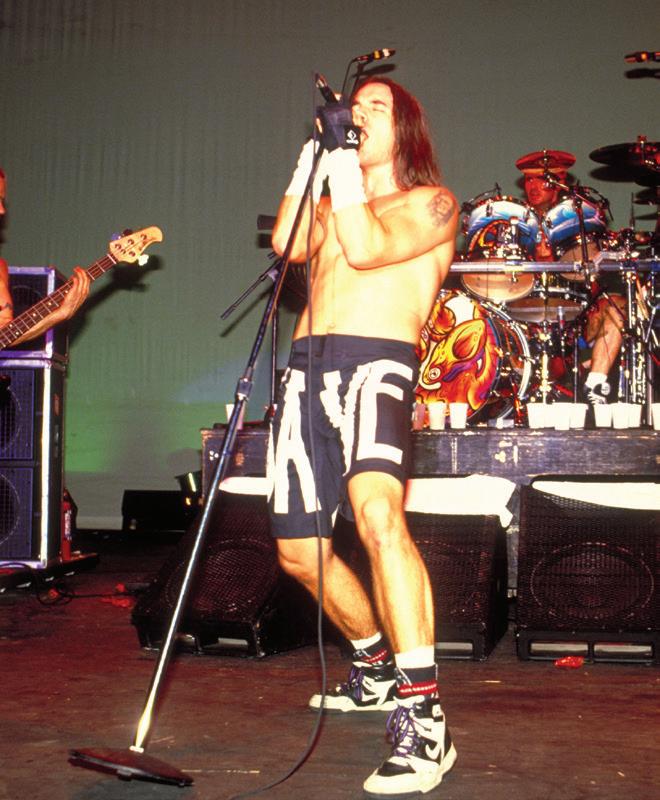
10 minute read
THE Invincible BAND
“Oafish trolls” turned mature, artful Beatlefunkers, RED HOT CHILI PEPPERS deftly mask their daily combat with the goblins of smack, back pain and, er. genital waving. How do they do that? “It’s all smoke and mirrors, my friend.”

In their two decades together, Red Hot Chili Peppers have seen their share of the dark side of Los Angeles: the crumbling apartments, the seedy bars and, famously, that spot “under the bridge downtown” where their frontman Anthony Kiedis scored heroin, later immortalizing it in a hit song. During one of his bleaker moments, Kiedis once described L.A. as “a stifling land of smog, violence and hate.”
However, on a Monday morning in May 2002, Red Hot Chili Peppers found themselves in a part of town better suited to their buoyant mood. Santa Monica’s Casa Del Mar Hotel reeked of money. In the foyer hung a colossal wroughtiron chandelier cradling a copper boat. In a bar the size of a tennis court, guests surveyed the Pacific Ocean.
Upstairs, in three opulent two-story suites, the band gathered for the first public airing of their album, By the Way, for a room full of press. First to arrive was Bassist Michael “Flea” Balzary, twisted like a pretzel into some implausible yoga pose. Next was Kiedis, sporting a precisely trimmed goatee. Then there was errant guitarist John Frusciante, who aided the band’s path to megastardom, left to spend five years in the clutches of heroin addiction, and returned in 1998. He resembled Vincent Gallo playing Jesus of Nazareth, another famous resurrectee. Finally, baseball-capped drummer Chad Smith barreled in, clearly not long out of bed. “I thought it was noon,” he jovially protested.
“Nobody does interviews before noon!”
You wouldn’t immediately put these four men together, but their mutual affection is transparent. Flea and Smith make a wisecracking, sarcastic double act. Alongside Frusciante, Flea is more sincere and almost paternally protective. Kiedis and Frusciante comprise the most intense alliance.
When an interviewer asked Kiedis for a precis of the band’s history, Kiedis gamely rattled off a condensed chronology, but was practically incomprehensible to anyone not acquainted with their contorted family tree. “I wish Mel Brooks was here,” he sighed.
“Our history would be much funnier.”
As Kiedis later told British magazine Q, they have been on the verge of calling it a day at least four times, usually in the wake of a disappearing guitar player. And then there were the bits that Kiedis opted not to share with the press, namely their previous Herculean drug intake. Heroin killed founding guitarist Hillel Slovak in 1988, poleaxed Frusciante and has plagued Kiedis intermittently.
By 2002 their number of albums (eight) was finally higher than their tally of guitarists (seven). “Is that a brief history?” the frontman asked when he finished. Then, as if he’d temporarily forgotten the whole point. “Oh, we had fun. We had a lot of fun, too.”
It’s now been 40 years since the band formed in 1983. If anybody decides to make a Red Hot Chili Peppers biopic, the most apt title has already been taken by M. Night Shyamalan: Unbreakable. The tagline they could filch from Nietzsche: what doesn’t kill them makes them stronger.
Before By the Way was released in 2002, it had been five years since the band last contemplated dissolving, a record for them. In 1997, Dave Navarro, the Jane’s Addiction guitarist recruited to replace Frusciante, wasn’t fitting in and the album he appeared on 1995’s muddled One Hot Minute, was both a commercial and creative disappointment. Kiedis had been using heroin again, while Flea and Smith were ready to quit.
Read any interview from that period and you’ll see that the group are masters of “We’ve never been happier” rhetoric, even when the truth was very different. But by 2002, it was hard to disbelieve them. By the Way marked only the second time they have recorded two successive albums with the same line-up. The last occasion was during Frusciante’s first stint: Mother’s Milk (1989) and Blood Sugar Sex Magik (1991). If the guitarist’s departure derailed the band after the breakthrough success of the later album’s 8.85 million sales, now there was nothing to stop them building on the unexpected career high of ‘99’s Californication, which has cleared a remarkable 12.5 million copies.
Rick Rubin was back in the producer’s chair for the fourth time in a row—Kiedis said they never considered anyone else—but By the Way did not chart familiar territory. Aside from a brief flurry on the title track, there was no sign at all of their trademark funk- metal. Instead, there were mellifluous harmonies (think Smile-era Beach Boys and any-era Beatles), avant-garde quirks and the most fluid, untethered playing of their career. Frusciante had gone all Jonny Greenwood, expanding his repertoire to synthesizers, mellotron and overdubs, and taking inspiration from techno boffins Autechre and Boards of Canada. In late 2000, he and Flea moonlighted on Tricky’s Blowback album and formed an unnamed Joy Division covers band for just one gig: consequently, the bassist’s playing now owes more to Peter Hook than Bootsy Collins. Kiedis’s songwriting, meanwhile, was wise and persuasive. It would not, however, be a Red Hot Chili Peppers record without some strife along the way. Towards the end of the Californication tour, Frusciante was locked into a stressful relationship and suffering from psychosomatic back pain. For much of that same period Flea was even worse, reeling from a traumatic break-up with his girlfriend of five years and wracked by panic attacks.
However, mid-way through the tour, Flea experienced an epiphany after a conversation with self-help writer Caroline Myss. “She said, ‘Everytime you go on stage you feel you have to prove something to the audience and you don’t have to prove s**t. You’re gonna kill yourself that way.’ And it was some of the best advice I ever got in my life. That was definitely a watershed moment.” Frusciante and Kiedis worked on the vocals and overdubs for several months at the Chateau Marmont, where the guitarist was living. It seemed strange for Frusciante to return to the same hotel where he almost wasted away at the height of his heroin addiction in ’97, but Kiedis contends otherwise. “There’s no reason to pretend like it didn’t happen. It was pretty dismal and scary but we lived through it.”
None of the band needed prompting to sing Frusciante’s praises. When the guitarist was first in the band he was closer to Kiedis than Flea, but it was the latter who maintained a friendship in the following years while the singer simmered with “animosity.”
During the frustration following One Hot Minute, Flea told Kiedis that if they didn’t try to get Frusciante back, he was leaving. So, after a fraught separation from Navarro, that’s just what they did.

“All that resentment just evaporated instantly,” said Kiedis. “It’s like a boyfriend-girlfriend thing. Sometimes you’re so f**king hurt by somebody that you won’t allow yourself to be friends with them. It doesn’t mean that deep down you don’t love them. But, you know, ego. Ego and mind games.”
“New Agey as it sounds, I think we were put on this planet to make this special, magical music,” said Smith. “When he came back we realized that. We don’t take it for granted now.”
And what a curious chemistry it is. They don’t live in each other’s pockets anymore, nor has their friendship become a mere business arrangement. Their bond is both genuine and, to the outsider, unfathomable.
As Rick Rubin said, “They’re very different individuals. Each has their own world.”
Flea (“because I was little and jumped around a lot”) is the Chili Pepper who most personifies the band’s contradictions. He’s the one with the dyed hair and the daft voices (which he’s employed in The Big Lebowski and cartoon The Wild Thornberrys) and the fondness for disrobing on stage. But he’s also the meditator who prays before every meal and who likes Kurosawa films and avant-garde jazz. In the rockstar DNA blender, he’s equal parts Thom Yorke, Sting and Blink-182’s Tome Delonge; a strange brew.
Until Rubin introduced him to transcendental meditation in the mid-’90s, Flea’s tendency to ricochet between extremes was even more dizzying. “When I first met Flea, it was difficult for him to communicate,” said Rubin. “He’d be racing off in a lot of different directions and not making much sense.”
Until 1992, Flea alternated between voracious drug consumption and short-lived puritanical spells. Like Kiedis and Frusciante, Flea also got sober, but knows the “oafish troll” image, which he was once called in the press, lingers.
“Anyone’s feelings would be hurt when people say you’re an asshole,” he reasoned. “Y’know, sexist frat-rock, jock, shallowminded party music. But does it impress people that I read Celine and listen to Thelonious Monk and watch Cassavetes films? I don’t know. Stuff in the center of pop culture has never really interested me that much.”

The Red Hot Chili Peppers’ status as the Lollapalooza generation’s class clowns, multi-platinum sellers and reluctant godfathers of rap-metal has obscured their left-field origins. In their early years, when other L.A. metal bands wore spandex, they worked with George Clinton, Gang of Four’s Andy Gill and Captain Beefheart’s drummer, Cliff Martinez. But then, if the Art Ensemble of Chicago had appeared on album sleeves with socks over their penises—as the Chili Peppers did on ‘88s Abbey Road EP—they’d probably have had credibility problems, too. But, as Smith explained, “We may jump around with socks on our dicks, but when it comes to making records, we don’t take things lightly.”
Still, despite the Chili Peppers’ somewhat boisterous sexuality, and a run-in with the Florida police after spanking a female stage invader in 1990, Flea bristled at charges of sexism.
“Perhaps I’m wrong, perhaps I didn’t feel we were ever sexist. I always felt very much in the feminine. So I don’t feel that different, I just feel a desire now, if I can, to contribute to the feminist cause.”
Only a Californian could say such a sentence with a straight face. Did he, then, regret the wrong impression given by his previous exploits?
“I don’t really mind, I embrace the c**k-waving lunatic. I think it had its place.” Is he gone for good?
“No, the c**k waving lunatic likes to have a laugh. Perhaps the c**k-waving lunatic is more conscious of how he affects other people.”
Flea’s only regret about the old days is his promiscuity. In 2002 he described himself as, “a bachelor, man. [Mock bawling] A lonely man nearing 40 and I don’t have a girlfriend.” Today, he’s a father of three and married to fashion designer Melody Ehsani.
Though musicians habitually claim that music is their life, few take that credo quite so literally as John Frusciante. He first won his place in the band with note-perfect renditions of every Hillel Slovak guitar part and still practices from dawn till dusk.
Although better than he once was, he had a precarious grip on the world outside music during his interview in 2002. He didn't drive (in L.A., the heigh of eccentricity) or follow the news—and it showed.
“Making art is about accepting what’s going on around you and turning it into something beautiful, no matter what it is,” he mumbled. “During this record we had the catastrophe at the Empire State Building and we just kept on writing.”
Being the only man in America who wasn't sure which building collapsed on September 11 may be alarming but, after what Frusciante’s been through, it’s perhaps enough that he’s still alive.
When he auditioned for the Chili Peppers he was still in his teens (he’s 53 now) and his militantly punk ethic didn’t gel with the life in a rock band in the first flush of global success. His reaction was to recoil.
“I was smoking pot night and day and I went through the world thinking it should be the way I believe it should be. And if it’s not like that, then I’ll shut that part of the world out. I was scared I’d lose my ability to be creative. I thought being a heroin addict and making my life nothing but good feelings was the best way to maintain being a creative person. But it’s not.”
After leaving the group in ‘92, Frusciante slowly faded from view. He released two minor solo albums (1995’s Niandra Lades and Usually Just a T-shirt and ‘97’s Smile from the Streets You Hold), later admitting he cobbled together the latter purely to raise drug money. By the time an L.A. reporter tracked him down to the Chateau Marmont in early ‘97, he was all but forgotten.
“It got to the point where there was nobody looking at me the way people look at you when you’re famous, with that love even though they don’t know you,” he said. “I was getting physical pain. I felt like childhood traumas that I had never even felt existed were now coming up to get me. This life that we’re thrust into when we become rock stars acts as a kind of detour for us and we don’t even realize that it’s happening. We just take it for granted.”
Frusciante returned to the group for the recording of Californication and at the time of his interview in 2002, he was utterly convinced that he would never relapse. “I’m not scared of going back on drugs. I don’t see it as being a possibility.”
Why? “I guess I’m just lucky. I like people smoking pot around me. I really just like the way it smells.”
When Frusciante removed his lumberjack jacket, his arms were a ruin of scars and patches. He said that when he looks at an old picture of himself—lean and boyish and still in possession of his own teeth—he doesn’t recognize that person.
“I remember it like I’m remembering somebody else’s life. I remember how spirits at that time were plaguing me and insulting me all the time. It was good. Because what I was capable of compared to what I was doing was so huge, so the spirits were giving me hell for it.”
Do you still get those spirits?
“They like me now,” he beamed. “I know how to work hard to make them happy. I like the idea that I’ll never be in the position of having nothing to eat and nowhere to live again. And I love being able to buy as many records as I want to buy.”
During the recording of By the Way, Red Hot Chili Peppers decorated the studio in order to feel more at home. Some members brought tapestries or film noir posters or incense. Chad Smith brought a picture of dogs playing poker. “You familiar with that one?” he said with a throaty laugh. “Ha! That was my inspiration.”
Smith is one of those drummers who seem to consider it their duty to act in a drummer-like manner. He once attended a “drum clinic” in England with fellow sticksmen from the likes of Jamiroquai, the Prodigy and Iron Maiden. It sounds like the setup to a lightbulb joke. “Drummers are the nice guys of the band,” he said. “They’re more normal and stuff. Those guys out front, I dunno about them.”










